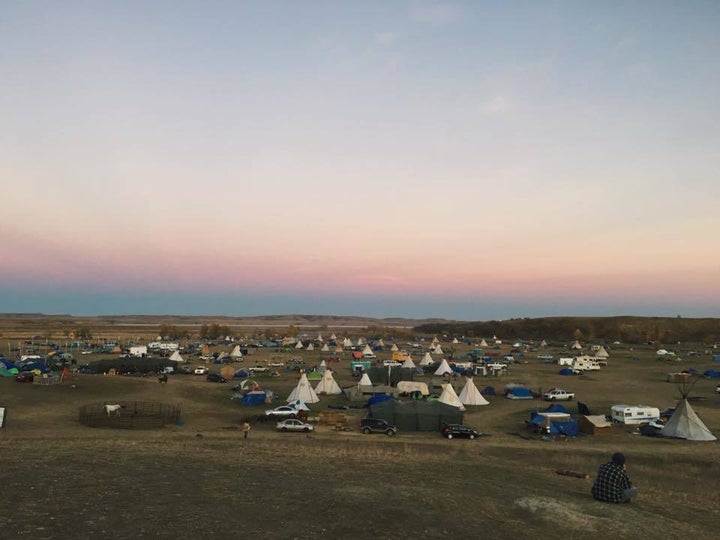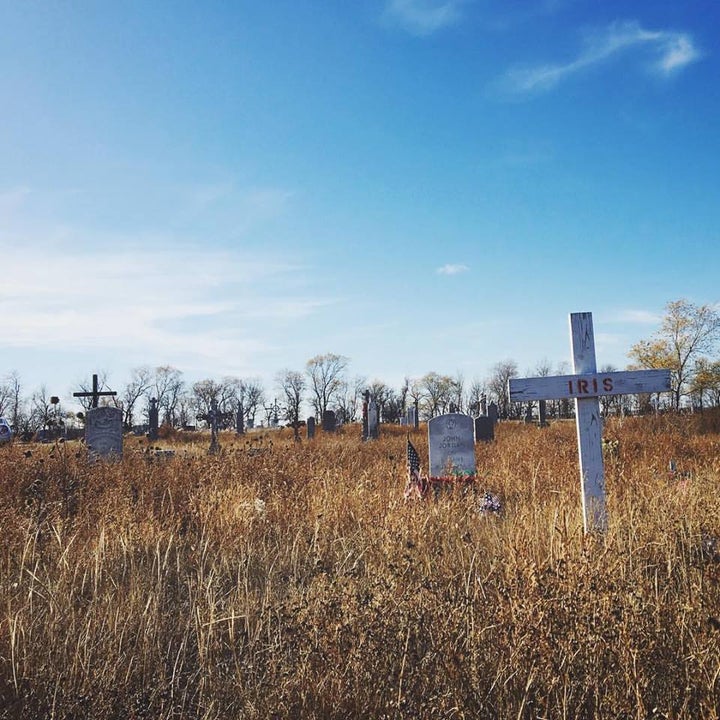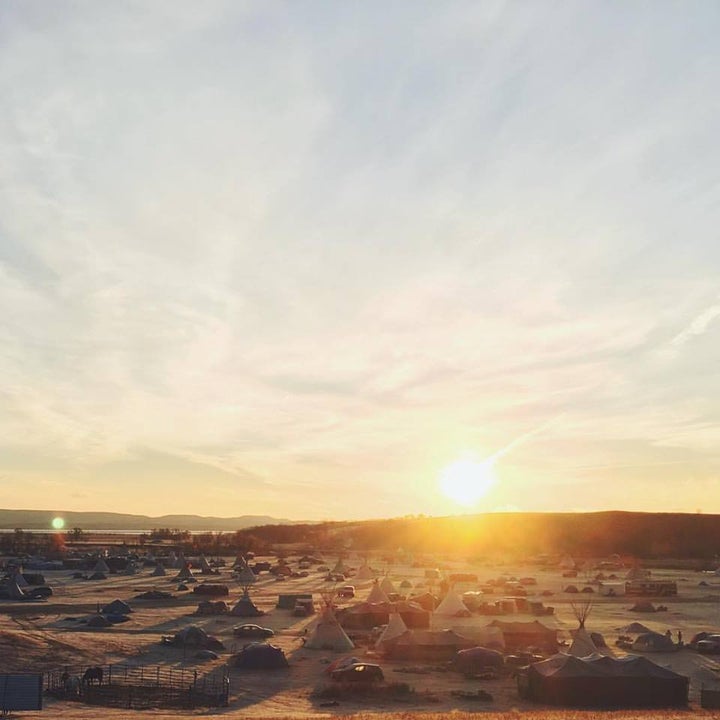
I’m home now in Chicago, but I was at Standing Rock just a few days ago. I know how it feels to sleep outside in two sleeping bags and a winter coat in below-freezing weather, and wake up to the sounds of people coughing from tents surrounding you. I remember feeling the ground shake as horses stampeded past on the way to the front lines. I can hear the elders on the microphone—the voice of the camp at the sacred fire—urging non-violence, keeping everything grounded in prayer and ceremony.
The camps at Standing Rock are the final hold out against the Dakota Access Pipeline, being constructed by Dakota Access and Energy Transfer Partners. These fields in central North Dakota are where the pipeline would cross the longest river in the United States—the Missouri River—putting drinking water at risk for millions of people and desecrating sacred indigenous land.
After a week at Standing Rock, I can’t focus on anything but the news, Facebook live feeds, and photos pouring across social media. I feel helpless for the situation and the people on the front lines. Yesterday, hundreds of militarized police bore down on the unarmed, self-proclaimed “water protectors” who were singing, praying, and walking along the pipeline construction site.
One woman shared publicly on Facebook: “I seen an 18-year-old young man get shot while on a horse today—then his horse. I was standing 20 feet away. I seen young warriors on horse being chased on ATVs, being shot at. I seen our former chairman get arrested. I seen an unci (grandma) get maced right in the face. I seen the cops drag two men from the sweat lodge feet from me…in their underwear and slammed face down into the ground and arrested. All these crimes were committed against our people on land guaranteed to our people under the Fort Laramie Treaty of 1851.”
I felt compelled to make the 13-hour drive to Standing Rock, having reported on the Keystone Pipeline over the past two years and wanting to witness history in action. When I arrived at the Oceti Sakowin camp at Standing Rock, I planned to register with the media tent and report on what was happening. But as I parked and climbed out of my car, two teenage boys riding bareback on horses stopped me. Red bandanas covered their faces.
“Where’s the action?” They demanded, talking over each other. I’d just seen dozens of people take off in cars and on foot toward the pipeline construction site a few miles up Highway 1806. I pointed that way. The boys leaned into their horses, tapped them with their heels, and let out warrior cries as they rode off.
“This is land that originally belonged to the tribe as a result of the Fort Laramie treaty of 1851.”
That’s when I decided to experience Standing Rock first as a human being, not as a member of the press. The camps represent a coming together of tribes from across the country and people from around the world. They sit at the crossroads of incredibly complex issues: public health, environmental justice, First Amendment rights, and indigenous rights.
The Issues
By allowing Dakota Access to dig under the Missouri River to run this pipeline, the government is putting private interest before the public’s health. Flint, Michigan showed us what a water crisis looks like on a relatively small scale—“small” being an entire city.
By allowing the fossil fuel industry to occupy the land and rivers of the United States instead of shifting to renewable energy sources such as wind, solar, and geothermal, the government is putting private interest before the environment. In the past 12 months alone, North Dakota reported 272 uncontained oil spills, defined as “an overflow of the facility boundaries or a leak from a facility pipeline.” Contained oil spills: 904 in North Dakota alone.
By allowing this construction to happen on indigenous land, the government is putting private interest before Native American treaty rights. In September, the construction company dug up human remains from a Native American burial ground, which is why dozens of campers are occupying the land at this specific location, directly beside the burial ground. This is land that originally belonged to the tribe as a result of the Fort Laramie treaty of 1851.
By allowing journalists and peaceful protestors to be arrested and strip-searched, the government is putting private interest before people’s First Amendment rights. Among those arrested recently was journalist Amy Goodman, who had reported on security guards releasing attack dogs on protesters at the pipeline construction site. The state of North Dakota charged Goodman with rioting, but the judge dismissed the case in October, which Goodman called “a complete vindication of my right as a journalist to cover the attack on the protesters, and of the public’s right to know what is happening with the Dakota Access pipeline.”
Currently, there are an estimated 1,000 people camped out at Standing Rock. This drawing by Francisco de Pajaro sums up the situation nicely. I saw license plates from almost all 50 states, and I met both Native Americans and non-natives dedicated to protecting the water and land from contamination.

The People
A cancer survivor and former tribal police officer from Arizona had set up camp next to me. He said that the moral weight of his job had driven him to alcoholism, but on the day we met, he was celebrating nine years sober. Back in Arizona, he now works as an electrician and had recently hooked up electricity for an elder who had gone 15 years without it. It had taken him four hours to fix what she had lived without for over a decade, he said. And he refused to accept payment from her.
At the sacred fire—a ceremonial fire at the center of the camp that people kept burning day and night—I talked to a medic from Toronto, Canada. She had spent the morning at the front lines with two emergency “oh-shit” bags strapped to her legs. She’d promised her husband that she wouldn’t get arrested, but had been “all over those front lines” for the past two months, unable to leave the escalating situation.
“The government is putting private interest before the environment.”
There was also a woman who drove up from Cheyenne River Reservation in South Dakota to set up her own kitchen just beyond the sacred fire. She spent day and night cooking traditional Lakota food (buffalo stew, fry bread, and wojapi) for the people at the front lines and those in the camp—all for free.
Each day, the camp organized “actions.” These actions included water ceremonies, marches, or walking the line of police and shaking hands. I can’t imagine what this situation is like for the officers who are responding to the North Dakota governor’s orders, but who also drink the same water that the people of Standing Rock are trying to protect.
The Past
I spent my last day at camp driving around Standing Rock Reservation with my friend Samantha and her aunt, who had driven in from Missoula, Montana. After visiting Sitting Bull’s grave, we drove south across the reservation to the town of Kenel, where we found an overgrown cemetery next to a modest church.

At the center of the cemetery, a giant plaque lists the names of nearly 600 people, a not-so-distant reminder of what can happen when native people lose one of the only things they’ve been left with: their treaty rights. These names belong to the deceased whose unidentifiable remains were moved after the United States government declared eminent domain of reservation land in the 1950s. The government made the declaration in order to construct the Oahe Dam along the Missouri River.
As a result of construction and subsequent flooding, the Cheyenne River Indian Reservation and Standing Rock Indian Reservation lost hundreds of thousands of acres, including prime agricultural land. The government resettled the people to places where the soil’s clay content was too high for harvesting and medicinal plants were less prevalent, causing the people to become less self-sufficient and more reliant on the government for food and healthcare.
The Future
If you don’t understand what’s happening at Standing Rock or think protesting is a waste of time, remember that people coming together to speak out against something raises public awareness. This awareness eventually can lead to public policy changes.
Without labor unions taking to the streets in the 1800s, we wouldn’t have two days off a week or an eight-hour standard workday. Without people rallying together in the early 1900s, women wouldn’t have the right to vote—and we definitely wouldn’t have a major party nominating a woman for president. Without the March on Washington in 1963, we wouldn’t have seen the end of segregation or the legal end to voter discrimination.
At Standing Rock, it didn’t matter that I was a white person. It mattered that I went. What happens there—to the water, to the people, and to the land—affects all of us. If this movement fails, we will feel its echoes for years to come.

